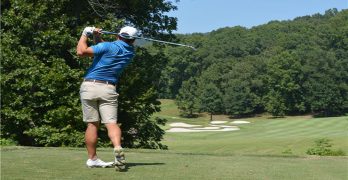Before smartphones were readily available in our pockets, analyzing your golf swing was a difficult task. In years past, golfers hoping to improve their swings by analyzing and critiquing would need to set up a tripod and a video camera to capture video or rely on their golf professional or swing instructor to handle the video capturing and analysis of their swing. [Read more…]
Do My Clubs Need New Grips?
Golf grips are an integral part of your golf equipment and should be cared for extensively. Like a car’s tires, grips are the all-important surface that begins your voyage through the golf swing. Avid golfers typically handle their grips with care and change them regularly. Beginner golfers often find themselves with grips detrimental to their swings and games. [Read more…]
Should You Play 9 Holes Or 18?
When it comes to golf in the modern age, a lot of people feel like they don’t have the time to dedicate to going out on the golf course for hours at a time. [Read more…]
4 Drills To Do EVERY Time At The Range
As the saying goes, “practice makes perfect,” and this applies to many things — including golf. A great place to put in quality practice time is at the driving range, but if you’re like most golfers, your typical range practice may not be as effective as you think. Does your usual range routine consist of working through your clubs from wedge to driver one by one, not moving on to the next club until you’ve grooved your swing? Or even worse, you quickly thrash through your bucket of balls by seeing how far you can hit them with your driver?
If this is the case, and you’re serious about improving your golf swing, then you need a more productive way to spend your time while out on the driving range. One great way to add focus to your practice time is to incorporate some simple drills into your practice routine.
Drills can help your golf swing in many ways, so we’ve put together a list of four drills to do every time you’re at the range.
1. Practice like you’re on the course
Never spend all of your time on the range just bashing away at one club. If you want your driving range practice to transfer to the golf course, then you need to simulate real course conditions. When you’re playing a round, you’ll rarely use a certain club twice in a row (unless it’s your putter), so you shouldn’t be doing this on the driving range.
Alternate between clubs such as 7-iron, driver, wedge, another driver, fairway wood and so on. Or even go one step further and imagine you’re playing a specific course you know. Tee it up on the first hole with the club you usually use and then continue “playing” the whole course, excluding putting. You could even find yardage books for famous courses like St. Andrews or Pebble Beach, so you can simulate a round on one of these to really test yourself.
2. Work on your pre-shot routine
Professional players on tour spend huge amounts of time practicing. But if you have ever watched a pro at the range, either on television or if you’re lucky enough at a tournament, you’ll notice that every shot they take has their full focus. They won’t just walk up and hit a few golf balls, they make sure before every swing that they go through a pre-shot routine. You’ll see them line up behind the golf ball, pick a target and visualize the shot. Then they’ll move into the ball, aligning their feet and body with the target, then use a movement — such as a waggle — to release any stress or tension in the body so they can start their backswing smoothly.
If you don’t have a pre-shot routine, then making one and practicing it should be your top priority on the range. The most important part of your pre-shot routine needs to be consistency. It can be personal to you, but you need to be able to repeat it time and time again on the range or on the course, especially when you’re under pressure.
3. Do a 9 to 3 golf drill
This is one of my personal favorite drills and it’s my go-to as soon as I get on the range. It’s the perfect way to warm up and really groove your swing, either before a practice session or a round.
The 9 to 3 drill is basically a shorter version of your golf swing. You take the club back to 9 o’clock (looking as if your body was a clock face on), waist height parallel to the ground on the backswing, then you swing to 3 o’clock the other side, so waist height parallel on the follow-through. You can use any club ranging from a wedge to a 6-iron. This is a great way to check if you’re swinging on plane and your clubface is staying square. Once you can hit clean straight shots like this, your swing will improve drastically, as this is basically 90 percent of the golf swing. Once the 9 to 3 swing feels grooved and you start hitting crisp shots, move onto your full swing.
4. Do target practice
However frustrating and difficult golf can be, remember that it’s also a sport — so try to enjoy it. Making up challenges or games on the range can be fun and help you practice with a purpose. If you are with a friend or playing partner, why not try picking targets on the range and challenge them to see who can hit each spot first? This is a great way to practice your alignment and aim, and also to help you deal with competition and pressure on the course. If you’re practicing alone you can still try this; pick some targets and give different points to each target depending on the difficulty of hitting them, then set a number to beat or try to beat your last high score.
Were any of these drills useful to you? Let us know in the comments. Also share if you have any other drills you do every time you’re at the range. Now get out there and get practicing!
— Joseph Mills



